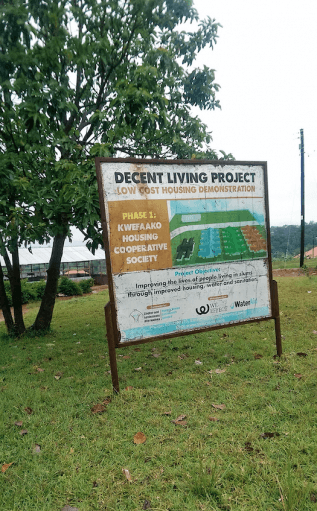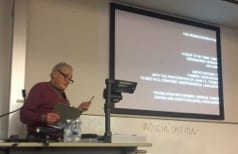MSc Development Administration and Planning 2017 Fieldtrip. Recount of the visit to the Bujjuko Low Cost Housing Demonstration
By ucfulsc, on 15 June 2017
The international field trip is an integral part of the MSc Development Administration and Planning Programme (DAP) and this year, the students travelled to Kampala, Uganda for their field trip. This is the second year running that the MSc DAP programme has been working with development partners in Kampala, Uganda. This year, the MSc DAP programme partnered with eight NGOs and CBOs which included; Community Integrated Development Initiatives (CIDI), ACTogether, Community Development Resource Network (CDRN), Children’s Rights and Lobby Mission (CALM Africa), Living Earth, Uganda, Kasubi Parish local Community Development Initiative (KALOCODE), Action for Community Development – Uganda (ACODEV- U). The 8th partner, Shelter and Settlement Alternatives (SSA), gave a site visit in which they showed the students one of their current projects – The Decent Living Project.

Development in Practice
The city of Kampala is experiencing rapid urbanisation. A city, which was originally built on seven hills, has now expanded to that on more than twenty hills, with informal settlements sprawling up in different parts of the city. Infrastructure in the city has not expanded on par with the rapid urbanisation and access to amenities is a challenge for the millions that inhabit or the thousands that troop into the city for employment. The city of Kampala is also going through massive regeneration and this is visualised through the many construction works going on in the city. As developers and inhabitants contest for the urban space, those who cannot afford to live in the city are forced to move to peri-urban areas and some are even forcefully evicted. However, some of the community members are establishing cooperatives and also working with non-governmental organisations to have access to land.
The central theme for this years’ field trip was examining how a development intervention is planned and implemented in Kampala, and the MSc students worked with their partners in understanding how Non-governmental organisations (NGOs) and community-based organisations (CBOs) in Kampala, Uganda, approach the planning and implementation of ‘development’.
One of the projects that the students visited was the Bujjuko Low Cost Housing Demonstration, which is a component of the Decent Living project implemented by Shelter and Settlements Alternatives SSA. The beneficiaries include the Kwefako positive living women’s group, who were previously living in an informal settlement in Kampala city centre and ended up being displaced. The group were living under poor conditions and with the fear of eviction before they were identified as a potential partner. The group were encouraged to form a cooperative because it was the best way to have the community organised. SSA and WaterAid initiated to assist the group. Hence, the Kwefako Housing cooperative was conceived and registered in 2014.

Participatory approach
Participatory approaches have been heralded in the development discourse as crucial in achieving sustainable development (Parfitt, 2004, Cleaver, 1999). However, it has also come under criticisms and raised questions about its effectiveness in truly empowering those in the grassroots (Parfitt, 2004).

The visit to the housing project offered an opportunity to understand how the beneficiaries influence the planning and implementation of development project from the start of the project to its completion. According to the SSA project assistant, participatory process was utilised in all phases of the housing project from the planning to the implementation stage. The project assistant stated that there were several consultations with the members of the cooperative on several issues ranging from what they wanted as a group to the location of the housing. On the question of location, a feasibility study was conducted with the input of the members of the cooperative. The members were then brought to the site of the proposed housing to see for themselves. The members agreed in relocating to the area because of its proximity and accessibility to markets, schools and places of worship. There are 34 members in the cooperative. 24 families are presently occupying the houses and 10 houses are going under construction for the remaining 10 members.
The Cooperative members were also given the ‘liberty’ to draw their dream homes and after several consultations, came up with the current design. Not only did they come up with the design, they also constructed the houses themselves using the blocks that they made. Each Unit costs 26 million UGX to build. The residents pay an upfront of 10 million UGX and then 70,000 UGX monthly giving them about 30 years to complete the payment. However, they can pay up before the 30 years period. The amount they pay for these homes were said to be similar to the rent they paid in the informal settlement. On defaulting in payment, the group stated that if a month’s payment is defaulted, members could go to SSA and come up with a payment plan agreement. Although, the residents stated that paying is a challenge, they have several sources of livelihoods such as making and selling crafts. SSA was also said to have carried out some capacity building workshops with the cooperative members and trained them in different income generating activities. And according to the residents, future plans of generating income include acquiring machines to make and sell blocks and also, start giving training workshops.


Transferring ownership. The cooperative members stated that members could not just sell their houses to anyone. There are agreements between all of the members when it comes to the transfer of ownership, especially if it is through selling of the house. To sell a house, a member must go through the following regulation:
- The person buying must be a member;
- The person selling must consult all the other residents and members of the cooperative;
- A member can buy
Appropriate Technology Transfer
Apart from capacity building, SSA also engages in appropriate technology transfer with the group. For instance, the interlocking soil stabilizing blocks that were used to construct the houses were made from the soil in the land. Further, the materials they use in sifting the soil is mostly made from local materials.

It was also mentioned that cultural and social issues were taken into consideration for this project. The use of interlocking soil stabilizing blocks was appropriate technology, which was suitable for the members. The site of the housing was suitable for the members and did not alter their social lives, rather enhanced it as they stated.
Residents now enjoy amenities that they did not previously have. Each house has a water tank and each family pay what they use.
There have also been other benefits from the project such as the national water extending water pipe to the community that the project is located in.
References
SSA: UHSNET Newsletter 2016.
Demonstrating Decent Living – A Publication of Shelter and Settlements Alternatives and Uganda Human Settlements Network.
Cleaver, F. (1999) Paradoxes of participation. Questioning participatory approaches to Development. Journal of International Development. Vol 11. No 4. Pg. 597
Parfitt, T. (2004) The ambiguity of participation: a qualified defence of participatory development. Third World Quarterly. Vol 25. Issue no 3
Dr Lilian Schofield is the Graduate Teaching Assistant for the MSc Development Administration and Planning (DAP). She has over five years experience working in Higher Education Institutions in the UK as well as experience in the development field having worked with development consultancies and NGOs in Nigeria. Lilian Schofield has a PhD in Construction and Property Management and investigated the role of stakeholders in housing development projects in poor communities in Nigeria.
 Close
Close












































